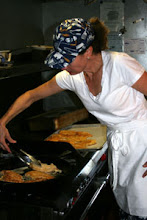I'm standing in line at the grocery store and the cashier starts ringing up my basket. He has to look up every single code on the produce, save bananas.
He's young.
When he picks up the Swiss chard, he says, "what's this?"

I tell him it's spinach on steroids. A light bulb goes off in his head.
And then he asks me what I do with it. Cook it, I say. Oh, he says, followed by how?
Now, he's maybe 16, so I know he's not going to go home and cook a batch of Swiss chard, but I tell him anyway, just in case. I mean, I'd like to think that the young ones are interested in cooking.
The first thing I do is trim the stalks from the stems. You can cook the stems, if you like, but they need more cooking than the leaves, and I don't like the texture, so I discard them (to the compost pile if you have one!)

Cutting the stem is like cutting a "V" from the leaf. Once the stems are removed, I fold the leaves in half, lengthwise and roll them up. Then I just chop them a few times.
Next, place them in a bowl and cover with cold water to rinse off any grit.

If the chard seems particularly dirty, give them another bath. Swish around the chard with your hand and then let them rest, so any dirt will sink to the bottom of the bowl. Gently grab a few handfuls at a time and place them in a salad spinner basket.
What? You don't have one? Why not? It was going to be No. 11 on my top ten list of best kitchen gadgets, but then it wouldn't have been a top ten list.

I like the OXO salad spinner, with the hand pump on top. Let's you get out a bit of aggression. They have two sizes, but the larger one is the most useful. I've given it as a gift to some of my favorite people.
I don't like the brands that have a pull string to spin the basket. Maybe I'm too rough with it, but I usually end up ripping the darn string out. The pump style is much more durable for people like me.
Back to the chard, the reason it needs to be dry is because we're going to saute it in a skillet with a little olive oil, maybe even a little garlic, but I'm getting ahead of myself here.
If it's not dry, then the water droplets will hit the oil and make it splatter. Messy.

Now, this pan looks ridiculously full. It is. And that's only about 2/3's of the batch. Pour about a tablespoon (or teaspoon if you're using a non stick pan and watching your girlish figure) into a pan and heat over medium heat. Add as much Swiss chard as you can fit, and it's OK if it mounds up higher than a kite.
Let it cook a couple minutes, then with tongs, gently start to turn the chard, pulling the leaves on the bottom up to the top. Soon, right before your very eyes, it will shrink. (And darken to an very unattractive shade of green, which is why I usually hide it underneath the rest of the meal.) As the chard wilts, add any extra that didn't fit in the pan.
Once it is all wilted, you can add some minced garlic and cook that in with the chard for flavor. Minced shallots, too, if you're feeling frisky.
It only takes about 7 to 8 minutes to fully cook. You know it's done when you taste it and it's tender but not mushy. Season with salt and pepper and call it a day.
I debated long and hard about whether or not to include this last picture. Cooked, chard isn't really all that attractive (hence, the hiding underneath, say beautiful sweet potatoes, or a saffron scented rice pilaf, for example).

Swiss chard is in season now and it's so good for you - full of those antioxidants the experts say we need (vitamins A, C and E) - plus a ton of vitamin K (good for blood clotting and bruise-healing) and a bunch of B vitamins to boot.
Despite the health benefits, I think it really tastes good.
Like spinach, on steroids, only better.






No comments:
Post a Comment